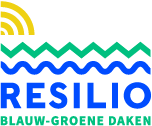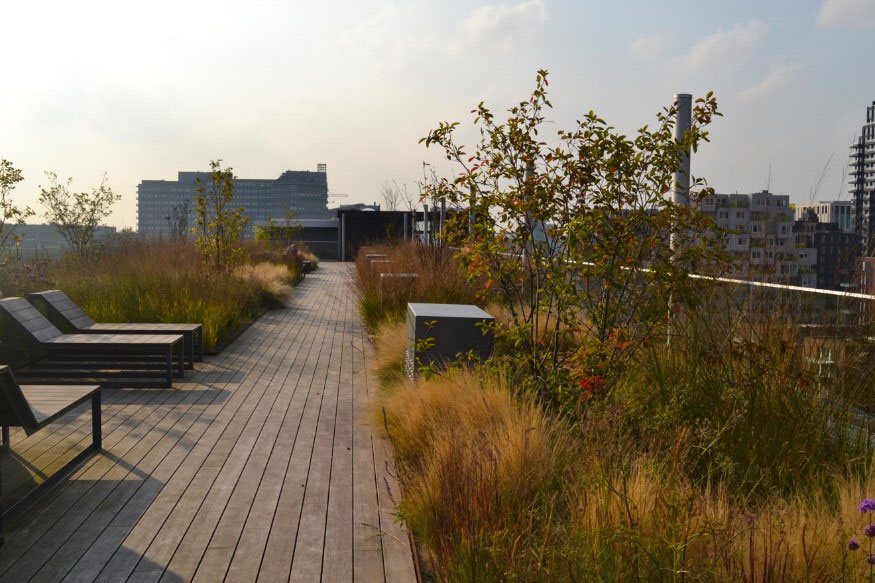An unexpected opportunity
As the RESILIO project had picked up in pace on the procurement and development of the new smart Blue-Green systems, the Covid19 crisis arrived and slowed down activities. However, the social and psychological impacts of confinement precisely due to this crisis, have highlighted the urgency for more accessible space. Blue-green roofs can really contribute to this.
Given that streets and parks as public spaces have not been designed to accommodate social distancing, many municipalities are now trying to find new accessible spaces for citizens. Private building roofs can be part of the solution spectrum when it comes to recreational space requirements.
This applies also to RESILIO whose BG roofs are on social housing corporations, yet the accessibility aspect did not hold a central part in the agenda – partially due to safety and maintenance concerns. However, the InnovationLab of the RESILIO project on the Benno Premselahuis, a building of the Amsterdam University of Applied Science (HvA), is accessible to the public and used as practical example to show residents and other stakeholders in Amsterdam the benefits of BG roofs.
The questions that now arise are “How do we practically leverage this new green space?“; “Where are the best opportunities and how do we strategically plan for them?”
Space reassignment opportunity
Many cities have a target for maximum distance from green for all inhabitants. The City of Amsterdam, together with Nijmegen and Utrecht, are involved in mapping projects to identify neighbourhoods that lack green spaces. Based on this information the municipalities identify the higher marginal positive effect of adding green spaces in these neighbourhoods, compared to others that already have such space.
In the Netherlands the areas that lack accessible green spaces are quite often in the historic areas and city centres. These areas have been build up over the ages, leaving very little space for green. These areas are many times also densely populated. This is an issue in the oldest part of Amsterdam, but also in, for example, Utrecht and Nijmegen.
The opportunity for space reassignment might not lie on eye level and therefore not be easy to spot. However, we might find space that can be easily reassigned on roof level.
An opportunity for well-being
Due to Covid19, a healthy relationship between humans and their home or office environment needs to be enhanced. In this context, blue-green roofs can offer:
- Socialisation opportunities to combat isolation and loneliness
- Urban gardening opportunities which build community
- Exercise space at a time that our living rooms are too small for this
- Safe playgrounds for children, whose emotional wellbeing can suffer from confinement and school closures
- Space to cool down on hot summer days. If citizens are left without options to cool down, it will put an additional burden on healthcare systems as people can suffer from heat-related symptoms.
Good practices for public utilisation and citizen engagement
There are some great examples of accessible green roofs that enhance social interaction in a safe way, while also offering the opportunity to enjoy green spaces while maintaining social distancing. See below the De Boel, FLOOR, CIRCL and DakAkker Roofs – some of the finest examples for public utilisation.
De Boel roof garden in Amsterdam Zuid is a great example (see photo above). The owner of the building, Vesteda, chose to create this park on top of the flat with rental apartments when renovating. The roof is redesigned using a smart blue-green roof. The area is accessible for all tenants.

FLOOR
FLOOR is another great example (an artist impression below). The renovation of the entire building (2017) consisted of the transformation from an office / school building to an apartment building. Two floors are added on top, with roof terraces on the top floor. In the original plans these terraces where planned on pebble roof. RESILIOS’s partner Rooftop Revolution convinced the owner to turn this into a blue-green roof and later on a smart function was added. The roof is accessible for the tenants on the top floor which is a huge benefit for them (adding also to the value of the property).
A small but important detail towards the success of the FLOOR project: in the original design the fencing was planned around the individual terraces and when adding the green roof, the fencing was moved to the outside, creating the idea of a park, rather than individual terraces.
 An artist impression of the FLOOR roof (Photo credits: the FLOOR project)
An artist impression of the FLOOR roof (Photo credits: the FLOOR project)
CIRCL roof garden
CIRCL roof garden in Amsterdam Zuid is another success story. This is the roof of the circular pavilion of ABN AMRO Bank in Amsterdam’s financial district. The building is built on a square, a public space, but the roof itself is also publicly accessible, thus the amount of public space that was lost due to the building’s construction is limited. The quality of the public space is enhanced, since the roof has a beautiful roof garden, planted only with plants meeting ecological criteria, creating a true oasis in this bustling area next to the railway station and in between high rise office buildings.

The CIRCL green roof seen from inside creating a connection with the natural and human external environment.
DakAkker
DakAkker in Rotterdam operates a community-run permaculture garden with a small restaurant and a smart blue-green roof. The DakAkker is about 1000 sqm rooftop farm and is the largest open-air roof farm in the Netherlands and one of the largest in Europe. The owner’s moto is “How to create a Sustainable City together”. For this reason it showcases how vegetables, edible flowers and fruit are grown and bees are kept. With the smart roof system, it has become a test-site for smart water storage and management.

People relaxing at the café on the DakAkker blue-green roof
Greening as a strategy for social distancing and addressing isolation
A communal space on the roof can provide an easy way to get some fresh air and meet people. In these times of social distancing, some people are anxious to go outside and people who already live in relative isolation face the risk to be isolated even more. A roof provides a safe space, very close to home, where one can relax without meeting other people than their neighbors. Also for people who don’t have a garden, green roofs can provide an alternative space to start gardening or grow their own crops.
We should start seeing roofs as potential gardens and stimulate usage and greening as much as possible. There is a big need for more green spaces in the city and this need has become even more urgent now that we need to keep social distancing regulations. Stress on space in public parks is high and sometimes parks need to be closed in order to be able to maintain the social distance regulations. If people who do not have a garden could relax on their roofs, stress on public spaces would turn a lot less critical.
In brief, perhaps it is the time to rethink how we manage our roofs and start providing those conditions (investment on safety, accessibility, landscaping) that render them accessible. This applies to our own RESILIO project and beyond.
Information: This is the second web article of a series to follow between 2020-2022 presenting ideas and news about RESILIO. Stay tuned!
Authors: Leon Kapetas is the UIA Expert for the RESILIO project (leonkapetas@gmail.com) & Jan Henk Tigelaar is the Director of Rooftop Revolution
Contact: Mr Age Niels Holstein (a.holstein@amsterdam.nl) – project manager of RESILIO), Leon Kapetas (leonkapetas@gmail.com) and Jan Henk Tigelaar (janhenk@rooftoprevolution.nl)

